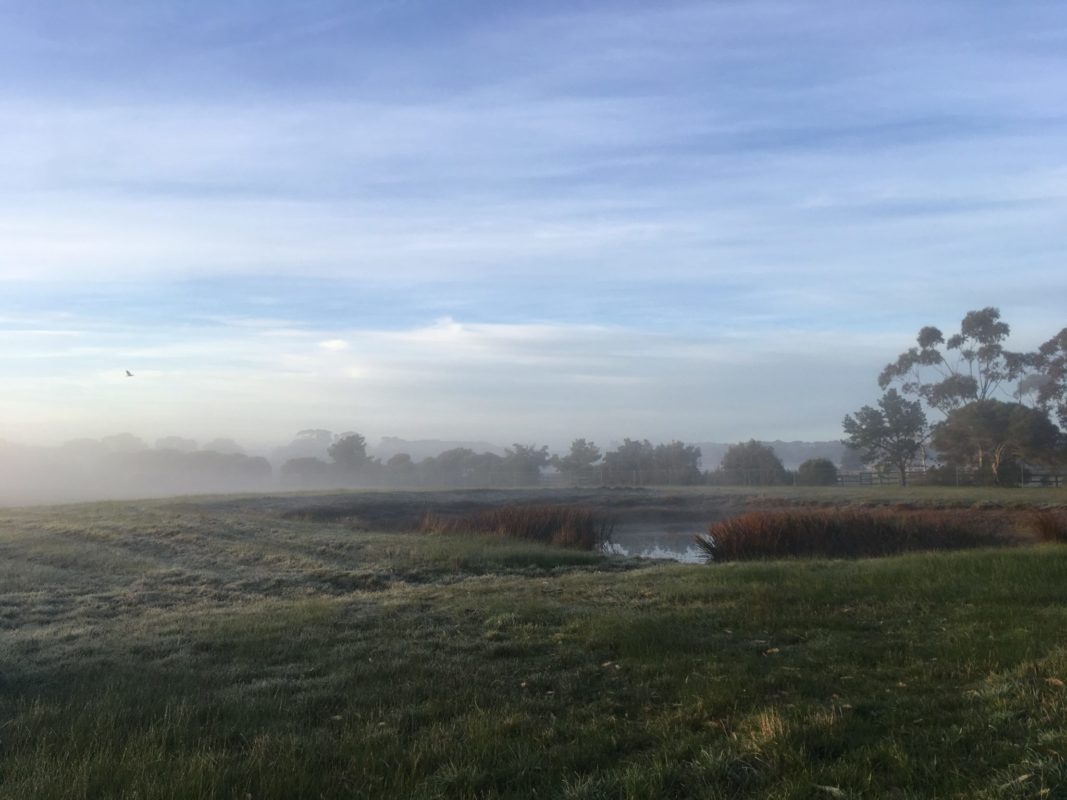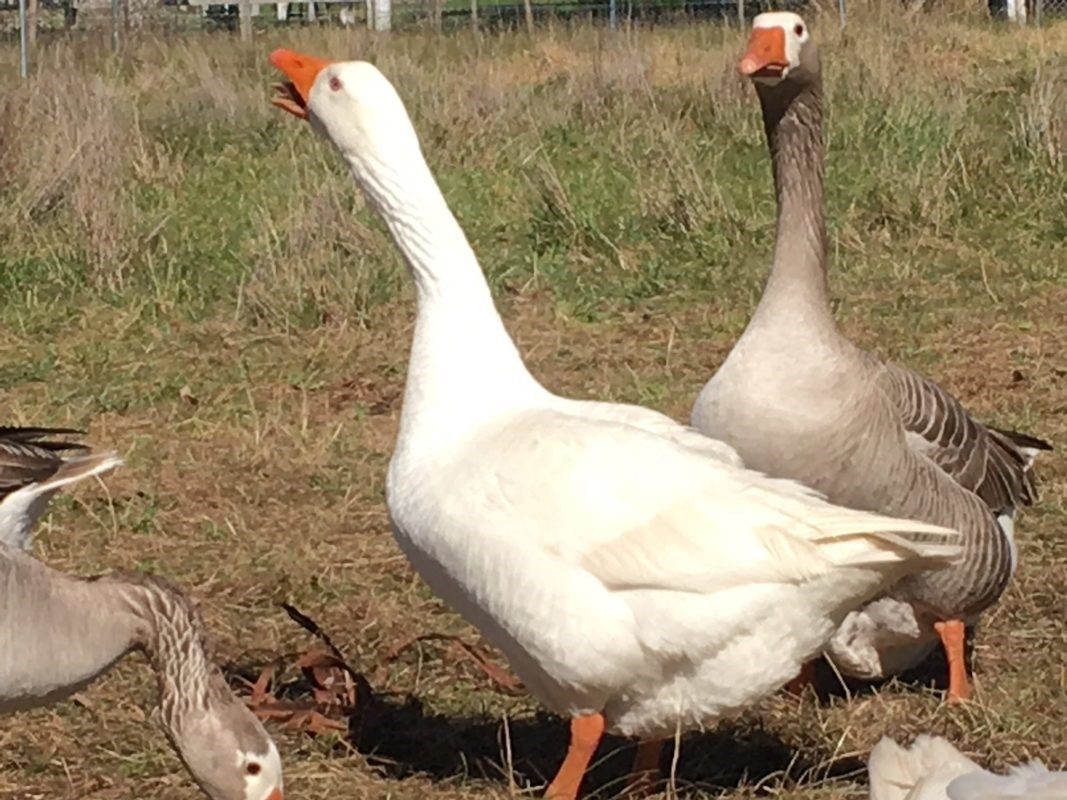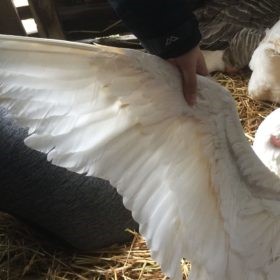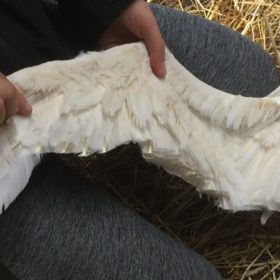Those of you who follow us on instagram or facebook, will already know that we bought 8 pilgrim geese. They seemed to be settling in to their paddock (although they prefer to be under the trees than in their shed) and pairing up for spring time egg laying. We’d actually already gotten a few eggs from one precocious couple.
In our planning, we’d decided to buy pilgrim geese as they lay a good number of eggs, can be heavy enough for a meat bird, and are auto-sexing. That is, the girls are grey, and the boys white, so you can tell gender apart easily and naturally. This is important for planning breeding, and for eating.
Geese can fly
Now pilgrim geese are also light enough that they make good garden weeders, and they can get off the ground if they need to. We have a 6 foot high fence around the property that they didn’t seem able to make it over. However, 7 of the 8 would regularly escape their small paddock (1.2m fences) and wander to our dam, leaving their mate desolately honking behind them.
This went on for about a month. The geese were happy. We were slightly less happy, but accepting. We considered clipping their wings, but honestly, it seemed like a large amount of yearly effort. It also seemed somewhat grey ethically. The fact is that geese, unlike other farmed poultry haven’t been bred so intensively as to lose their wild flight capabilities. To take that away seemed unnecessarily cruel. Finally, while our fence had proven to be fox proof for the last 6 months, allowing our geese to keep their wings gives them more protection against other predators, like wedge tailed eagles, and hawks.
But then. Oh my goodness. On Monday morning we were both running late for our off farm work. Matt left the house in a mad dash, and ran to the paddocks to check the animal’s feed and water. Unfortunately, the rush of him leaving the house and slamming the door was too much kerfuffle for our flightly geese! They startled and took off. All 8 got off the ground, 7 only flying a little distance and remaining in their paddock. One got quite high- we were worried it would make it over the fence. Instead it crashed straight into it, at speed. And fell straight to earth with a dull thud. The other two: one goose, one gander, made it over.
The gander landed in next door’s paddock- a flash of white amongst a mob of sheep. The goose landed too, but quickly took off again, and kept going. We didn’t see it land again.
One goose down
Matt was very late for work by this point. I ran next door in nothing but a pair of tracksuit pants and my dressing gown (farming is so glamourous!). With many false starts, and herding in circles, I got the gander out of the sheep paddock! It promptly crossed the road and attached itself to a few horses. These horse paddocks are surrounded by electric fencing that the gander could simply slip under. At 7 months pregnant I was much less nimble! After 20 minutes fruitlessly following this gander around, a groom at the property helped me herd him off the property.
The funny part is that as soon as he saw our driveway, he bolted down it, towards the sound of his friends, even waiting patiently at the electric fence for me to let him in.
I went back down the road to see if I could find our missing grey goose. By this stage I was very late. I saw no signs of her, and neither had any of the other neighbours. Eventually I gave up, consoling myself that at least she was free- she clearly had wanted to escape. Naively optimistic, I convinced myself she had settled happily in a neighbours dam, and was grazing their superior pasture. Matt confided later that he assumed she’d flown to peninsula link and gotten killed! But as it was, I headed to work, disappointed but not too distressed.
I got home around 5:30pm. And I found the goose. She was dead on the side of the road, belly split open, and blood smeared on the road. She had walked all the way back to the end of our driveway and then been hit by a car. We believe she was instantly killed by the car so there was no suffering. But that was little consolation.
Clipping geese wings
I had come to terms with the fact that we might never see her again. That her life would likely be shorter in the wild than in our well protected paddocks. But to see that she had tried to come home. Had, in fact, very nearly made it! I was horrified. I blamed myself, for not looking harder that morning, and I blamed Matt, for startling them in the first place. And every time I started to move onto something else, I was reminded by the mournful call of her mate.
So. We decided to clip the wings of our geese. It wasn’t a pleasant experience for any of us (although it was quite quick in the end). We clipped the flight feathers of one wing, to within two inches of the skin. You can certainly clip shorter: most recommendations are one inch. And to be honest, when one got off the ground soon after, we nearly regretted it! But I believe it was a good choice. Our geese can still use their wings to lift their heavy bodies off the ground, and move quite quickly. But they can no longer get out of our main paddock.
Have we restricted their freedom? Yes. But are we comfortable with the decision we made? Yes. Perhaps in the future we’ll look at getting a different breed of goose, with less fight capabilities, to make the wing clipping unneccessary. But for know, we’re happy with the shade of grey we’ve found.





I need to buy some two female and two male
Hi Muyingo,
Thanks for your message. I would try your local poultry club or a classifieds website like Gumtree or Craigslist.
Good luck!
Matt